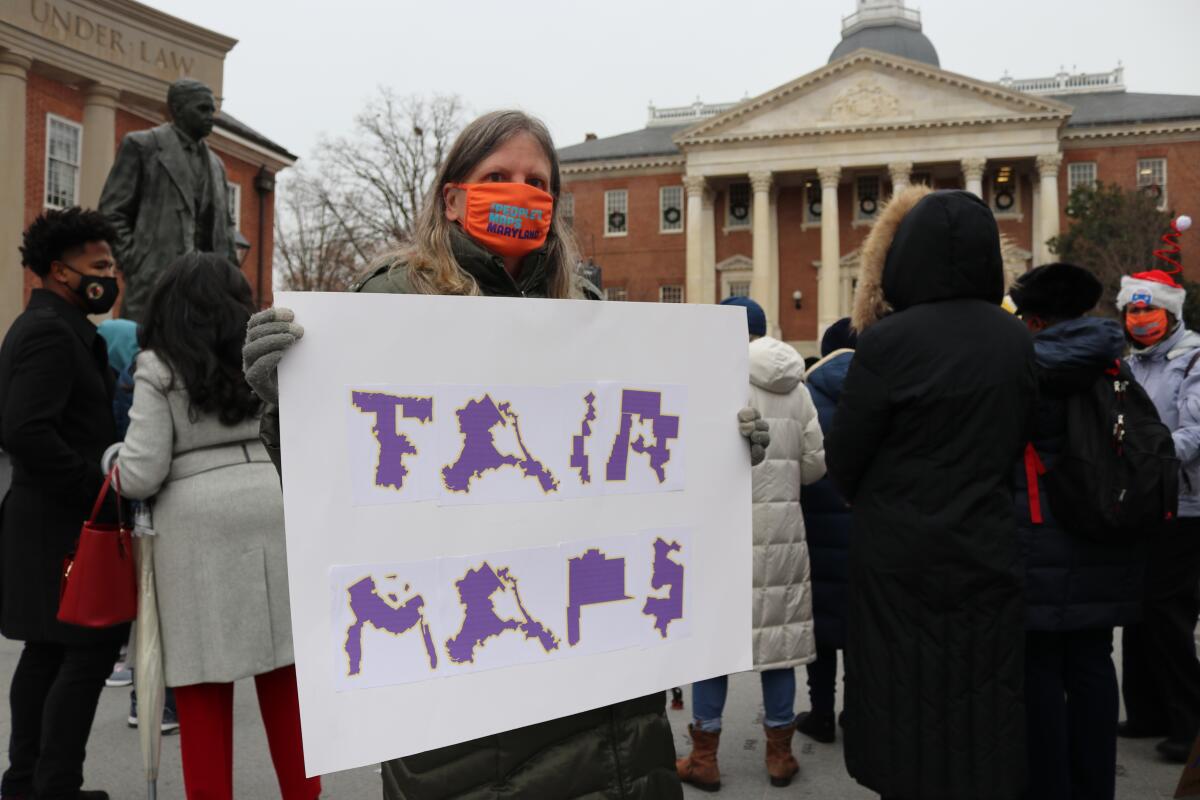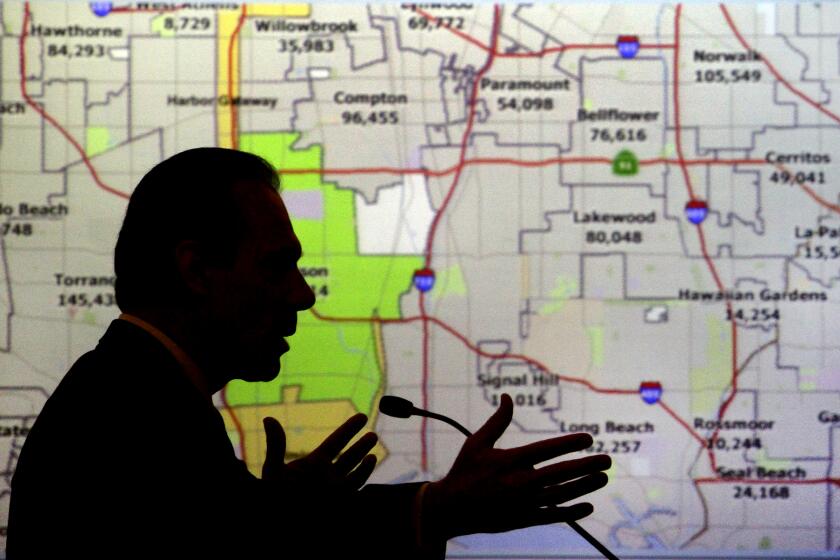Why new congressional maps don’t help the GOP as much as Democrats feared

- Share via
WASHINGTON — In 2022, it’s out with the old maps, and in with the new.
Redistricting, the once-in-a-decade redrawing of congressional and state legislative maps based on the U.S. Census, is underway, but things are pretty different this time.
The latest redrawing session follows a decade of ambitious voter reforms, seismic changes to the legal landscape, demographic shifts that have rearranged political power and a pandemic that has condensed and complicated the timeline for completing redistricting on-time.
The congressional maps that emerge in the coming months will determine whose voices are heard in Washington and shape the balance of power there for years to come.
The two parties have taken different approaches to drawing the maps where they have control: Republicans are generally shoring up their gains over the last decade, while Democrats are searching for new opportunities for blue seats. GOP lawmakers control map drawing in states covering 187 congressional districts, while Democrats control 75 seats. Independent commissions or states with split party rule are set to draw the rest.
Congressional maps in at least 10 states face challenges in state and federal courts, according to All About Redistricting, a database run by Loyola Law School, and more lawsuits are expected.
History is not on Democrats’ side in the upcoming midterm elections. The party is also hampered by issues over which it has little control.
“Most of the time, if your side is not in control, you have very little incentive not to sue,” Jason Torchinsky, a Republican lawyer whose clients include the National Republican Redistricting Trust.
Of the maps that have been approved, several have endangered the political futures of members of Congress. Rep. Adam Kinzinger (R-Ill.) retired after Democrats in his state (which lost a congressional district) eliminated his seat, while Rep. G.K. Butterfield (D-N.C.) directly cited Republican map drawing in his decision to not seek reelection. New district lines have forced incumbents to primary each other in Michigan, Georgia and West Virginia.
But electoral maps are about more than the fate of any one politician, or party.
Below is our guide to navigating the major changes to the redistricting process this cycle.
Why the Census delay matters
The Census results that states use to draw their maps weren’t released until August 2020, five months later than planned. That delay has forced states to rush the mapping process or extend deadlines.
“Everybody is crunched,” said Marina Jenkins, the director of litigation and policy at the National Democratic Redistricting Committee. “A number of states had timelines that demanded unrealistic and very difficult mapping schedules. And in some states … they continued to take their time, perhaps cynically, to delay the possibility of having that map challenged.”
In North Carolina, the state Supreme Court halted candidate filing last month and pushed the March primary election back two months while it considers challenges against the map lawmakers approved in the fall. Many courts will be reluctant to take a similar approach.
“A judge doesn’t want to create that disruption,” said Doug Spencer, a law professor at the University of Colorado and the head of All About Redistricting. “So the closer we get to the filing deadlines, the more likely courts are to just maintain the current maps for 2022.”
The delay has also changed who gets to draw the maps. In some states, independent commissions missed deadlines for drawing maps and had to hand the job over to another body.
The Supreme Court effect
For the first time in decades, mapmakers in 15 states with histories of voter discrimination will now be free to implement maps without federal approval.
From 1965, when the Voting Rights Act passed, until 2013, states including Texas, Alabama and Virginia, as well as certain counties in states like California, needed to seek federal approval, or preclearance, if they wanted to make changes to their voting laws. In 2013, the Supreme Court ruled in Shelby vs. Holder that the decades-old formula used to determine which states needed to seek preclearance was outdated.
That’s allowed states with a history of making it harder for people of color to vote to enact broad changes, including passing new voter ID laws, closing polling places, and now redraw maps, without government oversight.
News Analysis: ‘There is no Plan B’: Biden trading one challenge for another with voting rights push
After failing to push through his social spending bill, President Biden turns to voting rights legislation, a pivot advocates say is long overdue.
In Texas, the new congressional map is being challenged in court for potentially diluting the influence of voters of color. While the Census found that Latinos, Black Americans and other minority groups made up 95% of the massive population growth that earned the state two new congressional districts, the state’s new map did not include any districts reflecting that change. The Department of Justice announced Dec. 6 it was suing to overturn the state’s congressional map.
If the state were still subject to federal approval, the department likely would have blocked the map before it went into effect.
“Now the burden is on DOJ to convince the court that the map is discriminatory,” said Michael Li, senior counsel for the democracy program at the Brennan Center, a law and policy institute. “It’s a totally different ballgame.”
More recently, the Supreme Court has also made it harder for political groups and parties to challenge partisan gerrymanders — maps drawn in a way that appear to unfairly benefit one party.
In 2019’s Rucho vs. Common Cause, the Supreme Court considered complaints from Democrats in North Carolina and Republicans in Maryland that maps drawn by the opposing party created partisan gerrymanders. While the court agreed the maps in question were “highly partisan,” it ruled such cases “present political questions beyond the reach of the federal courts.”
As a result, those cases are instead playing out in state courts, where results are influenced by the political leanings of specific panels and how they interpret the voter protections in their state constitutions.
What about independent commissions?
Independent commissions debuted in Colorado, Michigan, Ohio, Utah and Virginia last year. In Colorado and Michigan, the commissions are made up of bipartisan groups of citizens (not chosen by lawmakers). Both their maps added new competitive districts and have received positive ratings for partisan fairness from the Princeton Gerrymandering Project.
But this cycle has shown that not all reforms are created equal: “What we’ve learned is that the structure of the commission matters a lot,” said Adam Podowitz-Thomas a senior legal strategist of the Princeton group.
In Utah, the legislature voted in 2020 to water down the commission’s power by giving it an advisory role. While the commission’s proposed maps would have created one seat favoring Democrats and three favoring Republicans, the legislature approved a map with four solidly Republican seats.
In Ohio, where voters approved a ballot measure in 2018 to encourage fairness and explicitly ban partisan gerrymandering, a seven-member panel of politicians failed to approve new congressional maps by the deadline, leaving the task to the GOP-controlled legislature. Soon after the map was signed into law in November, the League of Women Voters of Ohio and others challenged the map, arguing that it violates a clause in the state constitution against favoring one party over another.
In New York — which lost one congressional seat this year — Democrats in the state legislature appear ready to disregard maps from the state’s new advisory independent commission and draft maps that boost their party’s margin.
Two parties, two approaches
In 2010, Republicans flipped more than a dozen state legislative chambers, giving them a significant advantage in redrawing congressional districts during the 2011 redistricting cycle.
Last year, Democrats attempted to win back some of those legislatures ahead of this years’ map drawing. While Democrats were unsuccessful, Republicans don’t appear likely to gain a significant number of seats through redistricting.
Instead, they’ve taken up a new strategy: make red seats redder.
Republicans in most states didn’t undertake what Li of the Brennan Center calls “land grab” gerrymanders — essentially using the map to create more GOP-leaning districts. Instead, they’ve shored up the districts they already hold, protecting them from the demographic changes that allowed Democrats to flip GOP-held seats in the tail end of the last decade.
Spencer, of All About Redistricting, said Republicans will likely have a net gain of two to three seats nationwide that lean in their favor when redistricting is complete. “Republicans did such a good job of gerrymandering in 2010 that they didn’t have a lot of room to grow,” he said.
The challenge asserts the commission ‘is betraying its founding charter — to take control of redistricting away from the California Legislature.’
Democrats, however, are making an effort to create new blue seats in the states where they have control. The Princeton Gerrymandering Project gave F grades on partisan fairness to maps drawn by Democratic legislatures in Illinois, Oregon and Maryland. In New York, where Republicans currently hold eight congressional districts, experts predict Republicans could lose up to five seats if Democrats are aggressive.
Democrats say that unlike Republicans, maps drawn by their party reflect the changing diversity of the country and keep communities intact.
“It’s just not apples to apples,” Jenkins of the Democratic redistricting group said of the comparison. “The maps in Democratic states are representing their voters in a way that reflects reality, in a way that is not happening in Texas, for example.”
The Princeton project has also given F grades to Texas’ congressional map and a proposed map out of Ohio. Georgia’s pending map received a C. Several states have yet to receive a grade.
National Republicans say their path to controlling the House doesn’t depend on redistricting.
“Republicans have had the same mindset throughout the redistricting process … redistricting alone is not going to deliver a majority for House Republicans,” said Michael McAdams, the NRCC’s communications director. “We’re going to need to run competitive races all over the country in order to win a majority for the third time in nearly 70 years.”
More to Read
Get the L.A. Times Politics newsletter
Deeply reported insights into legislation, politics and policy from Sacramento, Washington and beyond. In your inbox twice per week.
You may occasionally receive promotional content from the Los Angeles Times.












